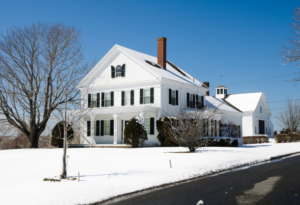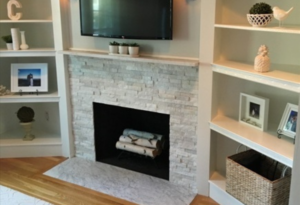Fueling Your Ambiance: Gas or Wood Fireplaces – Which Ignites Your Style?
The heart of a New England home often centers around a crackling fire, its warmth chasing away the winter chill with a comforting glow. But if your traditional gas or wood fireplace sends more heat up the chimney than into your living room, or your newer home lacks the ambiance of a hearth, it’s time to consider which ignites your style. There are two primary options to fuel your ambiance: gas and wood. Which ignites your style?
 Wood-Burning Fireplaces
Wood-Burning Fireplaces
For traditionalists, the awe of a wood-burning fireplace is undeniable. The gentle scent of oak firewood drifting through the air, the soft crackle of logs, and the mesmerizing dancing flames offer an unbeatable ambiance. However, this rustic charm comes with its share of responsibilities:
- Maintenance: Chopping and storing firewood, cleaning ashes, and ensuring proper chimney ventilation demand attention.
- Regulations: Connecticut has strict rules on wood-burning appliances, requiring permits and inspections to ensure safety and air quality compliance.
- Efficiency: While wood can be a cost-effective heating source, open fireplaces lose significant heat up the chimney.
Gas Fireplaces
Modern gas fireplaces offer flip-of-a-switch convenience, providing instant warmth and realistic flames without frequent cleaning. But like any convenience, there are trade-offs:
- Fuel Cost: Natural gas or propane can be more expensive than firewood, but pipelines are commonly available in Glastonbury, Willington, and central CT townships.
- Authenticity: While gas logs are more realistic than ever before, they may not be sufficient to appeal to a traditionalist.
- Venting Options: An open hearth requires a chimney to expel contaminants; direct vent fireplaces require an external vent; ventless models offer installation flexibility but require specific safety considerations due to combustion byproducts.
Direct Vent Fireplaces
Direct vent fireplaces provide the ambiance of a wood or gas fireplace without heat loss or significant pollution.
- High Efficiency: A direct-vent fireplace is an insert with a sealed combustion system that vents directly outside, minimizing heat loss and pollution while maximizing efficiency.
- Realistic Flames: Advanced gas log technology creates flames that resemble a realistic wood fire experience. Your secret is safe with us!
- Installation Flexibility: Unlike traditional wood fireplaces, direct vent models can be installed in interior walls in virtually any room in the home – kitchen, den, bedrooms, and even bathrooms, in some cases.
Ventless or Vent Free Fireplaces
Ventless fireplaces offer the ultimate convenience, requiring no chimney or external venting. However, due to safety concerns about indoor air quality and incomplete combustion, these models require:
- Strict Safety Measures: Regular maintenance and proper ventilation are crucial to ensure safe operation.
- Local Regulations: Some municipalities in Connecticut restrict or even ban ventless fireplaces due to safety concerns.
- Limited Heat Output: These fireplaces are mainly for ambiance and supplemental heat. Ventless models are not recommended for primary heating.
Wood or Gas – Which Ignites Your Style
Ultimately, deciding between a gas or wood fireplace depends on personal preference and priorities. So, you will want to consider factors like:
Desired Ambiance
Do you crave the authentic crackle of wood or prefer the convenience of gas?
Maintenance Requirements
Both wood and gas fireplaces require annual inspections and professional cleaning by a professional chimney sweep. However, wood fireplaces require frequent firebox cleaning and ash removal between professional visits. On the other hand, gas fireplaces require light cleaning of dust and wiping the glass doors of gas residue. Are you comfortable with regular wood-burning chores or prefer a low-maintenance option?

Budget
Factor in fuel costs, installation expenses, and potential permit fees. If you have a limited budget, consider choosing a heating appliance that doesn’t require building a chimney.
Local Regulations
Whichever appliance you choose, ensure it complies with federal, state, and local fire and building codes.
Wood and Gas Fireplaces for Sale Near Me
Northeastern Chimney LLC is your premier CSIA-certified gas and wood fireplaces, inserts, and stoves provider, including installations, upgrades, and maintenance in Cheshire, East Hampton, Glastonbury, and surrounding central Connecticut townships. Call (860) 233-5770 or contact us online at to consult with a Certified Chimney Sweep®.
The post Fueling Your Ambiance: Gas or Wood Fireplaces – Which Ignites Your Style? appeared first on .
This post first appeared on https://www.mychimney.com




 Types of Fireplaces
Types of Fireplaces





